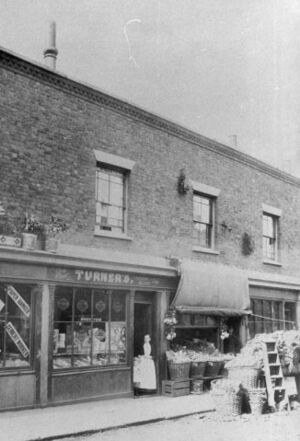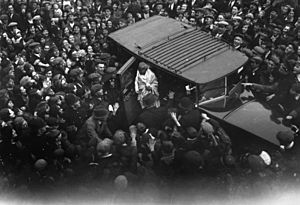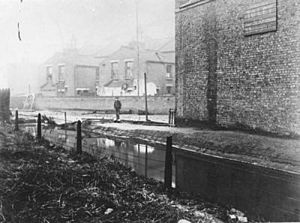Canning Town facts for kids
Quick facts for kids Canning Town |
|
|---|---|
 Royal Victoria Dock - with Canary Wharf and the O2 Arena in the background |
|
| Population | 42,667 (Canning Town North And Canning Town South wards, 2021) |
| OS grid reference | TQ4081 |
| London borough | |
| Ceremonial county | Greater London |
| Region | |
| Country | England |
| Sovereign state | United Kingdom |
| Post town | LONDON |
| Postcode district | E16, E13 |
| Dialling code | 020 |
| Police | Metropolitan |
| Fire | London |
| Ambulance | London |
| EU Parliament | London |
| UK Parliament |
|
| London Assembly | |
Canning Town is a district in the London Borough of Newham, East London, England, north of the Royal Victoria Dock. Its urbanisation was largely due to the creation of the dock. The area was part of the ancient parish of West Ham, in the hundred of Becontree, and the historic county of Essex. It forms part of the London E16 postcode district.
The area is undergoing significant regeneration as of 2012[update], with the building of up to 10,000 new homes.
Contents
History
Before the 19th century, the district was largely marshland, and accessible only by boat, or a toll bridge. In 1809, an Act of Parliament was passed for the construction of the Barking Road between the East India Docks and Barking. A five-span iron bridge was constructed in 1810 to carry the road across the River Lea at Bow Creek. This bridge was damaged by a collision with a collier in March 1887 and replaced by the London County Council (LCC) in 1896. This bridge was in turn replaced in 1934, at a site to the north and today's concrete flyover begun in smaller form in the 1960s, but successively modified to incorporate new road layouts for the upgraded A13 road and a feeder to the Limehouse Link tunnel, avoiding the Blackwall Tunnel. The abutments of the old iron bridge have now been utilised for the Jubilee footbridge, linking the area to Leamouth, in the London Borough of Tower Hamlets, on the western bank of the Lea.
The area is thought to be named after the first Viceroy of India, Charles John Canning, who suppressed the Indian Mutiny about the time the district expanded. The population increased rapidly after the North London Line was built from Stratford to North Woolwich, in 1846. This was built to carry coal and goods from the docks; and when the passenger station was first built it was known as Barking Road. Speculative builders constructed houses for the workers attracted by the new chemical industries established in the lower reaches of the River Lea, and for the nearby Thames Ironworks and Shipbuilding Company and Tate & Lyle refinery.
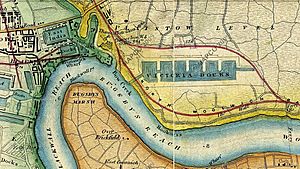

The opening of the Royal Victoria Dock in 1855 accelerated the development of the area creating employment and a need to house dock workers and their families. New settlements around the dock developed, starting with Hallsville, Canning Town and Woolwich, and later the areas now known as Custom House, Silvertown and West Silvertown. The new settlements lacked water supply and had no sewage system, leading to the spread of cholera and smallpox. The casual nature of employment at the docks meant poverty and squalid living conditions for many residents, and in 1857 Henry Morley wrote about the area:
"Canning Town is the child of the Victoria Docks. The condition of this place and of its neighbour prevents the steadier class of mechanics from residing in it. They go from their work to Stratford or to Plaistow. Many select such a dwelling place because they are already debased below the point of enmity to filth; poorer labourers live there, because they cannot afford to go farther, and there become debased. The Dock Company is surely, to a very great extent, answerable for the condition of the town they are creating. Not a few of the houses in it are built by poor and ignorant men who have saved a few hundred pounds, and are deluded by the prospect of a fatally cheap building investment."
The industries around the dock were often unhealthy and dangerous. As trade unions and political activists fought for better living conditions and the dock area became the centre of numerous movements with Will Thorne, James Keir Hardie and other later becoming leading figures in the Labour Party. Thorne and others worked and gave speeches at Canning Town Public Hall which had been built in 1894 as the population grew in the southern part of the borough.
From the late 19th century, a large African mariner community was established in Canning Town as a result of new shipping links to the Caribbean and West Africa. Prior to the Windrush era, Canning Town had London's largest black population of any area in London. The area around Crown Street (formerly located just north of the Royal Victoria Dock, but destroyed in the Blitz) was known as Draughtboard Alley due its ethnic mix.
Notable black people from Canning Town include footballers Fred Corbett, who played for Thames Ironworks F.C. and its successor team West Ham United; and Jack Leslie, who was called up to play for England, but then dropped without explanation, possibly due to racial prejudice. Another example of the area's long-standing multi-cultural nature is Indian-born doctor Chuni Lal Katial, who practised in Canning Town for several years from around 1929. Katial was an acquaintance of Mahatma Gandhi and invited him to meet Charlie Chaplin, one of the most famous actors in the world, at his surgery in Beckton Road. Gandhi was staying at Kingsley Hall, in nearby Bromley-by-Bow, for the three-month duration of his talks with the UK government on the future of India. Katial, a noted health pioneer, later moved to the Metropolitan Borough of Finsbury, in north London, where he became Britain's first south Asian Mayor.
In 1917 50 tons of TNT exploded at the Brunner Mond & Co ammunition work in nearby Silvertown, causing the Silvertown explosion, the largest explosion in London's history and damaging more than 70,000 buildings and killing 73 people.
In the 1930s the County Borough of West Ham commenced slum clearances. New houses, clinics, nurseries and a lido were opened. Silvertown ByPass and Britain's first flyover, the Silvertown Way, were built along with other new approach roads to the docks. Canning Town was heavily hit by the bombings in World War II and West Ham Council's plan to rebuild the area focused on a reduction of the population, transferring industry and the building of new housing such as the Keir Hardie Estate, which included schools and welfare services. In the early hours of 10 September 1940, a bomb hit South Hallsville School where up to 600 local refugees were accommodated. At least 200 were killed or injured.
The slum clearances and the devastation of World War II, destroying 85% of the housing stock, led to the preponderance of council estates that characterise the area today. Post-war housing schemes followed the urban planning principles of the garden city movement. As demand for housing grew the first high rise buildings were built in Canning Town in 1961. In 1968 part of Ronan Point, a 22-storey tower block in Newham, collapsed and most of the tall tower blocks built in the area in the early 1960s were eventually demolished or reduced in size.
Slum housing

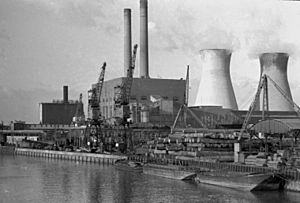
Victorian era
In 1857 Henry Morley published a detailed description of the area in Charles Dickens' Household Words entitled "Londoners over the Border", writing:
"...by the law there is one suburb on the border of the Essex marshes which is quite cut off from the comforts of the Metropolitan Buildings Act;-in fact, it lies just without its boundaries, and therefore is chosen as a place of refuge for offensive trade establishments turned out of the town, - those of oil boilers, gut spinners, varnish makers, printers ink makers and the like. Being cut off from the support of the Metropolitan Local Managing Act, this outskirt is free to possess new streets of houses without drains, roads, gas, or pavement."
Alfred Dickens highlighted the severe overcrowding suffered by many of the slum inhabitants as a result of landlord charging high rents and households relying on casual work.
20th century
The 1890 Housing Act made the local council responsible for providing decent accommodation, and in the 1890s some of the first council houses were built in Bethell Avenue. However, many of the terraced houses built during the late 19th century were little more than slums and cleared by the council in the 1930s. The council replaced the terraces with the first high-rise blocks.
Today
According to Newham London Borough Council, Canning Town and Custom House are among the five per cent most deprived areas in the UK. Residents suffer from poor health, low education and poverty. 17 per cent of the working age population have a limiting long-term illness, 17.5 per cent claim income support and 49.7 per cent of 16- to 74-year-olds have no formal qualifications.
Regeneration project
The consultation and governance mechanism of the currently ongoing regeneration project is underpinning by a partnership between councillors, residents, local businesses and other "partners". According to Newham council:
"The views of residents and businesses is central to the development and delivery of the regeneration initiative and developers will be expected to continue with extensive community consultation and engagement as part of their remit."
Newham council is currently attempting to encourage "re-interpretations" of London's established street and housing forms. The council has identified terraced housing as such housing form, stating that it "continues to have enduring popularity with all types of residents including families and children".
The area is at the western end of the Thames Gateway zone and is currently undergoing a £2.7 billion regeneration project, which includes:
- demolishing 2,750 homes and building 10,000 new homes
- creating 500,000 square metres of floor-space in a revitalised town centre
- providing community facilities, including a library, a health centre
- undertaking improvements to primary schools
The Olympic Uniform Distribution and Accreditation Centre, which was located in Canning Town, was due to be demolished and replaced with a new industrial estate as part of the Olympic Legacy programme.
Culture
Thames Ironworks F.C., the works team of the nearby Ironworks, went on to become West Ham United F.C. after turning professional.
The Bridge House, a public house named for the 1887 Iron Bridge, was at 23 Barking Road – now demolished. The venue operated during the 1970s and 1980s and was host to The Police, Depeche Mode, Jeff Beck, Billy Bragg, Alexis Korner, Modern Romance, Sham 69, Lindisfarne, The Cockney Rejects, Iron Maiden, Remus Down Boulevard and many other notable acts. A venue bearing the name The Bridge House 2 was opened in Bidder Street in more recent years.
Education
Transport
London Buses route 5, 69, 115, 147, 241, 300, 309, 323, 330, 474 and night routes N15, N550 and N551 all serve Canning Town at the bus station,
Route D3 starts/ends at Leamouth and route 276 runs on Barking Road, and 325 route at Canning Town Recreation Ground and Custom House, and route 473 and school route 678 start at Prince Regent bus station.




